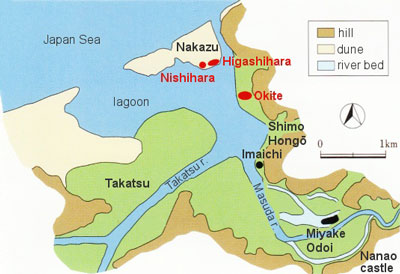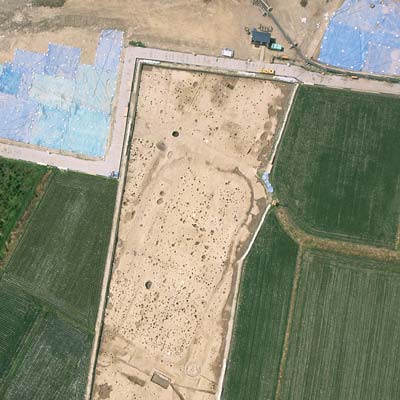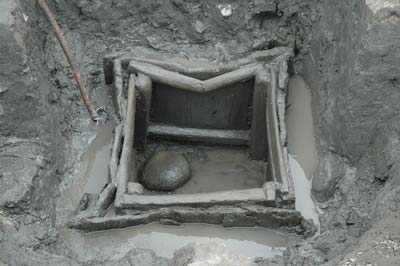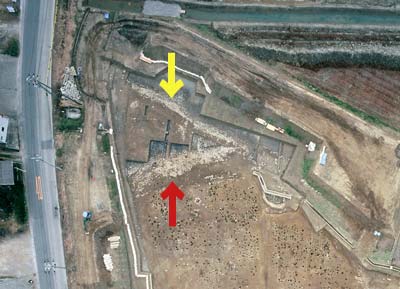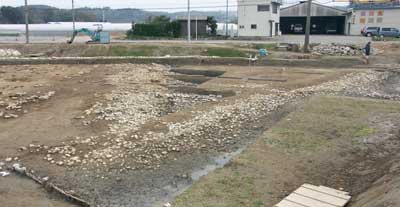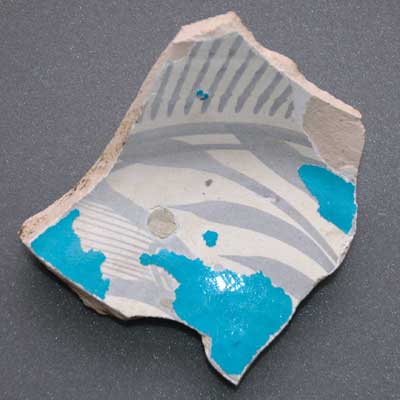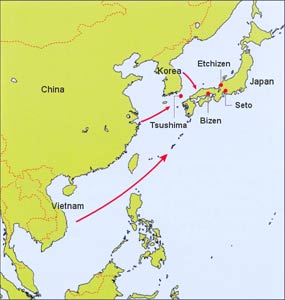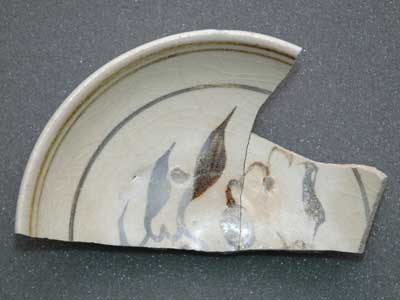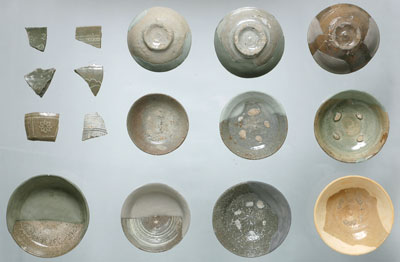Okite and Nakazu:
At a port and settlement where ships of foreign seas came and went, facilities of a Medieval harbor on the Japan Sea are discovered one after another.
Okite and Nakazu Sites, Masuda City, Shimane Prefecture
A wave of discoveries at a Medieval harbor
In a northern part of the city of Masuda, sandwiched between the mouths of two rivers flowing into the Japan Sea, harbor and settlement sites from the latter half of the eleventh through the sixteenth centuries have been discovered one after another in recent years. At the time, the mouths of the Masuda and Takatsu rivers are thought to have formed a shallow lagoon connecting with the sea, and a harbor is seen to have been located along its shores for ships sailing along the Japan Sea coast, as well as those conducting trade with the Korean peninsula or Chinese mainland.
The Okite site, a distribution base preceeding the Masuda clan
At the Okite site, a settlement which prospered from the latter half of the eleventh to the latter half of the twelfth centuries, the remains of approximately 140 embedded-pillar structures, plus wells, graves and so forth have been discovered. Roads with gutters, and multiple residences separated by fences, were laid out in planned fashion.
While no harbor facilities have been discovered, this is presumed to have been a town maintained by merchants and artisans as a base for the circulation and distribution of goods utilizing water transport, before the Masuda clan took full control of the area.
Discovery of a boat landing paved with cobbles
Seaward from Okite, the Nakazu Nishihara and Nakazu Higashihara sites are the remains of the harbor which flourished in the first half of the fifteenth century as a trading hub of the Masuda clan.
At the Nakazu Nishihara site, in addition to approximately 30 embedded-pillar buildings, graves and blacksmith furnaces were found, but most noteworthy is a cobble pavement thought to have been a boat landing.
The pavement was about 25 m long with a width of roughly 10 m, and a mooring post for anchoring boats still remained. From these dimensions it is presumed that large ocean-going could dock here. Later, because the river flowing into the lagoon changed course, the pavement was laid anew in a different direction, becoming approximately 30 m by 4 m in width.
Medieval harbors were not equipped with sea walls like those of the present day, and it is thought that the boats were pulled up onto the cobble pavement built at water's edge, where cargo was loaded and unloaded.
At the Nakazu Higashihara site as well, across a swamp and of the same period, excavation has confirmed the existence of cobble pavement.
Due to factors such as sedimentation, a marine regression in the latter half of the fourteenth century, and changes in the river course, conversion of the lagoon to dry land proceeded, and in the sixteenth century the harbor function moved upriver to Imaichi. (Kihara Hikaru)
Amassing wealth through trade, from manor official to samurai warlord
The Masuda manor, where the Okite, Nakazu Nishihara and Higashihara sites are located, came into being when an official named Fujiwara of the Iwami provincial government office developed the Masuda plain and its environs, and placed them under the patronage of an imperial regent house at court. Appointed as the manor's administrator, Fujiwara came to be called Masuda, and with its base at Masuda Hong? the family rose in position from the end of the Kamakura period as one of the major military groups of Iwami province, serving the Ōuchi and after their demise the Mōri clans from the Northern and Southern Courts period, and after the battle of Sekigahara moved their base to Susa of Abu county, in the province of Nagato, serving as elder official (karō) of the Hagi domain under the Mōri line until the end of the Edo period.
The Masuda clan of the Sengoku period were also maritime domainal lords, holding overseas trading bases such as parts of Hakata and the island of Mishima off the Hagi coast. The robust economic base built up through the aggressive pursuit of trade is thought to have helped raise their status vis a vis the Muromachi bakufu, and the ōuchi and Mōri clans.
A portrait of Masuda Kanetaka by the ink and wash painting master Sesshū survives (a designated Important Cultural Property), and the Masuda family archives, including as many as 800 Medieval documents, are in the collection of the Historiographical Institute of the University of Tokyo. (Kihara Hikaru)
